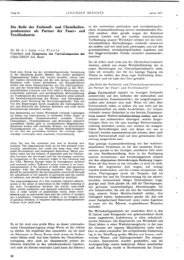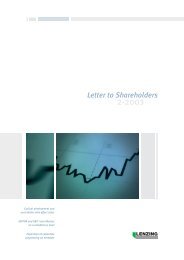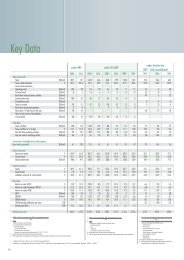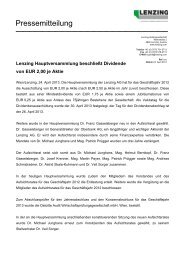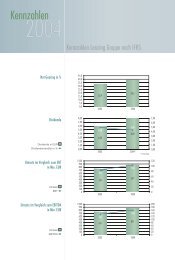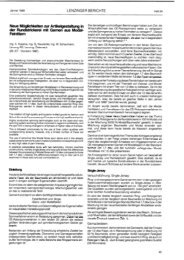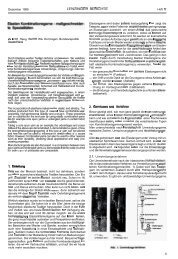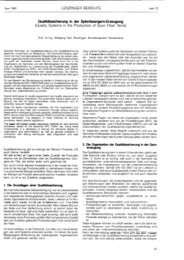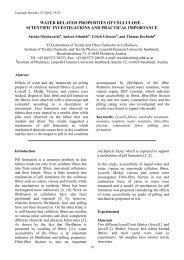Correlation of regenerated fibres morphology and surface ... - Lenzing
Correlation of regenerated fibres morphology and surface ... - Lenzing
Correlation of regenerated fibres morphology and surface ... - Lenzing
Create successful ePaper yourself
Turn your PDF publications into a flip-book with our unique Google optimized e-Paper software.
<strong>Lenzing</strong>er Berichte, 82 (2003) 83-95<br />
Fibre Treatment Long<br />
period<br />
nm<br />
Crystalli-nity<br />
index<br />
xfc<br />
Orientation<br />
function<br />
89<br />
fc<br />
*Voids<br />
volume<br />
cm 3 /g<br />
*Voids<br />
diameter<br />
nm<br />
*Inner<br />
<strong>surface</strong><br />
m²/g<br />
Tenacity<br />
cN/tex<br />
Viscose untreated 13.5 0.25 0.580 0.68 3.1 439 22.0<br />
bleaching 15.5 0.25 0.494 20.0<br />
mercerisation 15.6 0.38 0.722 19.5<br />
Modal untreated 13,5 0.37 0.706 0.49 2.4 409 34.0<br />
bleaching 13.7 0.44 0.583 32.0<br />
mercerisation 15.5 0.57 0.561 30.5<br />
Lyocell untreated 13.8 0.44 0.664 0.62 3.0 432 33.0<br />
bleaching 12.3 0.46 0.677 34.5<br />
mercerisation 13.0 0.50 0.768 27.0<br />
Table 3. Long periods, crystallinity index, Herman’s orientation function, *voids volume, diameter <strong>and</strong> inner <strong>surface</strong> <strong>of</strong><br />
voids (determined using Size Exclusion Chromatography) <strong>and</strong> tenacity <strong>of</strong> untreated <strong>and</strong> treated <strong>fibres</strong><br />
Wide angle X-ray scattering WAXS. All<br />
analysed <strong>fibres</strong> show intensive scattering with<br />
negligible differences between the solvent spun<br />
<strong>and</strong> the two other fibre types. Fibre treatment<br />
always causes separation <strong>of</strong> the scattering<br />
function’s peaks. The obtained results are<br />
presented in Table 3, one example <strong>of</strong> the<br />
r<strong>and</strong>omised scattering curves <strong>of</strong> viscose is<br />
shown in Figure 5.<br />
Crystallinity index. The crystallinity index<br />
(Figure 6) <strong>of</strong> viscose <strong>and</strong> modal <strong>fibres</strong> differ as<br />
expected, viscose has a lower crystallinity<br />
(0.25) than modal (0.37), lyocell <strong>fibres</strong> have the<br />
highest crystallinity index <strong>of</strong> 0.44. Any kind <strong>of</strong><br />
treatment significantly increases the<br />
crystallinity index, which agrees very well with<br />
those results given in the literature [15].<br />
Lyocell <strong>fibres</strong> are more stable than viscose or<br />
modal <strong>fibres</strong> in alkaline medium <strong>and</strong> therefore<br />
crystallinity increase is more pronounced for<br />
derivate spun cellulose <strong>fibres</strong> in comparison to<br />
solvent spun <strong>fibres</strong>. Viscose <strong>fibres</strong> crystallinity<br />
index is strongly dependent on the treatment<br />
conditions with an almost negligible increase<br />
caused by bleaching <strong>and</strong> a large increase caused<br />
by mercerisation (52%).<br />
The bleaching <strong>of</strong> viscose <strong>fibres</strong> may cause<br />
some oxidative damage <strong>and</strong> therefore a limited<br />
increase <strong>of</strong> crystallinity, nevertheless, it causes<br />
a significant increase <strong>of</strong> long spacing.<br />
A more pronounced crystallinity increase is<br />
observed after the bleaching <strong>of</strong> CMD (19%)<br />
<strong>and</strong> a strong one (53%) after alkaline treatment.<br />
Longer cellulose molecules in CMD <strong>fibres</strong> are<br />
less sensitive <strong>and</strong> more resistant to oxidative<br />
damages <strong>and</strong> therefore the influence <strong>of</strong> the<br />
alkaline environment predominates <strong>and</strong> an<br />
increase <strong>of</strong> crystallinity is observed.<br />
The large degree <strong>of</strong> polymerisation <strong>of</strong> about<br />
640 <strong>and</strong> the more complex structure are the<br />
reasons why lyocell <strong>fibres</strong> are more stable<br />
under any <strong>of</strong> the treatment conditions. A<br />
comparable small increase <strong>of</strong> crystallinity index<br />
occurs, however, <strong>and</strong> a correlation between the<br />
pH value <strong>of</strong> the treating medium <strong>and</strong> the<br />
crystallinity increase can be assumed. The pH<br />
value at bleaching is 10.7 <strong>and</strong> at mercerisation<br />
12.8, the increases <strong>of</strong> crystallinity 5% <strong>and</strong> 14%,<br />
respectively.<br />
Iodine sorption data confirms the X-ray results<br />
<strong>of</strong> crystallinity changes (Figure 7) especially<br />
when chemical changes caused by the oxidative<br />
bleaching process are taken into account. The<br />
lower the ISV the higher is the degree <strong>of</strong><br />
crystallinity. This data also show that there are<br />
only very small differences in lyocells<br />
crystallinity caused by both treatments.<br />
However, the degree <strong>of</strong> cellulose products<br />
oxidation influences the iodine sorption.<br />
Crystalline orientation. Fibres reactivity <strong>and</strong><br />
accessibility as well as tensile properties are<br />
mainly influenced by crystalline orientation.<br />
This parameter shows such different trends for<br />
each fibre type, that no unique model for its<br />
explanation could be established. Warwicker



